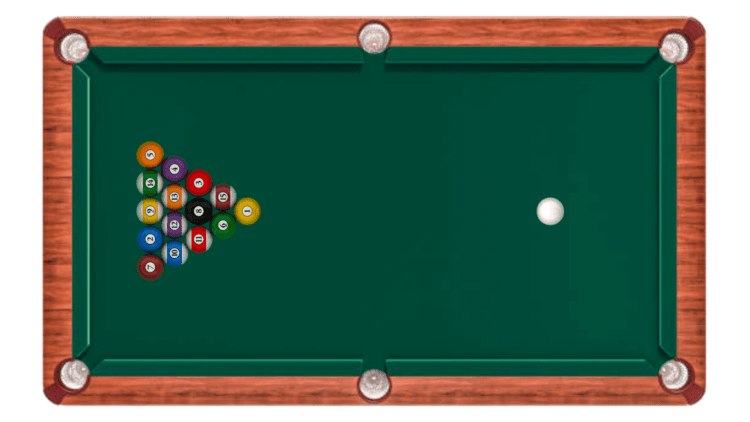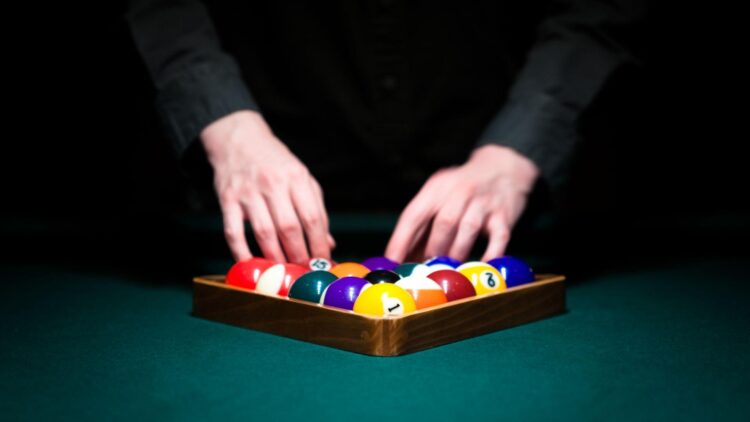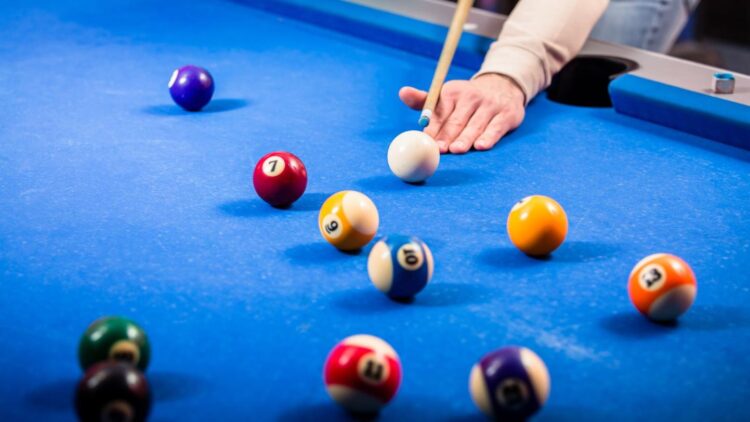
OBJECTIVE OF POOL: Legally pocket your 7 balls and then the 8 ball before your opponent.
NUMBER OF PLAYERS: 2 players
MATERIALS OF POOL: 2 pool cues, 1 cue ball, 1 pool table, 7 solid pool balls, 7 striped pool balls, 1 black 8 ball
TYPE OF GAME: Sport
AUDIENCE: Adult
OVERVIEW OF POOL
Pool began being played in the 1500s and, over time, has evolved into the classic bar game that we all know and love. Although players of all skill levels can play pool, it is also played at a professional level, and the game requires a surprising amount of skill to master. In this article, we will dive into the rules for pool and break down some of the different ways to play.
SETUP FOR POOL

WHAT YOU NEED TO PLAY POOL
- Numbered balls: Pool balls are either striped or solid and are numbered from 1 to 15. There are a total of 15 balls (only 9 are used for 9 ball pool)
- Cue Ball: A white ball that you hit with the cue towards the numbered balls.
- Cue: a long stick between 57 and 60 inches that is used to hit the cue ball
- Chalk: To give the end of the cue more grip, you can rub chalk on the tip.
- Racks: These are triangular or diamond-shaped objects that help set up the balls in the proper shape.
POOL TABLE
Pool tables come in various sizes, but the regulation size is 88 inches long and 44 inches wide. There are 6 pockets on the table, 1 pocket in each corner and 2 parallel pockets in the middle of the table. The wooden perimeter of the table is called the rail. The side rail goes along the long end of the table, and the head rail goes along the short end of the table. There is also a line going across one end of the table called the headstring.
RACKING

The first thing you’ll need to do before playing a pool game is racking the balls. Use the triangular rack for a standard 8 ball pool game.
Interestingly, there is a specific way that the balls should be placed in the rack
The yellow 1 ball should always be at the top, and then the other balls should be racked alternating between solid and stripes to keep an even distribution. Ensure that the black 8 ball is in the center of the rack, and then slide the triangle formation over the dotted marker on the pool table with the 1 ball directly over the dot.
Once the formation has been successfully formed, remove the triangular rack.
HOW TO PLAY POOL: 8 BALL POOL RULES
So, now that you have set up the game, it’s time to get into it with the official pool rules for 8 ball pool!
BREAKING
The break starts the pool game. To determine which player gets to break first, both players will both shoot a random ball toward the headrail. The player who lands their ball closest to the rail gets to decide whether or not to break first. After the first game, players will alternate breaking.
The player who breaks must place the cue ball behind the headstring and shoot the cue toward the triangle formation of balls. For a break to be considered legal, they must pocket at least one ball or move at least 4 balls to the rails.
If the breaker fails to do so, the opponent can either accept the table as it is, demand that the breaker re-rack and re-break, or re-rack and re-break themself. If the 8 ball goes into the pocket on the break, the non-breaking player can either decide to re-break or just return the 8 ball to the table. However, if the cue ball goes into the pocket on the break, the breaker loses their turn, and the opponent can place the cue ball anywhere on the table.
The ball the breaker makes into the pocket determines which type of ball they will shoot for the duration of the game. For example, if the breaker makes a striped ball into the pocket, they are designated to make striped balls in for the rest of the game and vice versa. The breaker can continue shooting until they miss a shot or scratch.
HOW TO HOLD A POOL CUE
Believe it or not, there is a right and a wrong way to hold a pool cue. But the most important thing is that it feels comfortable and natural.
First things first, grab the cue with your back hand – that’s the non-dominant one. Don’t go all Hulk on it; a gentle touch is the key. Now, slide your front hand slightly ahead of the back, forming a grip that feels just right. Remember, we’re aiming for a Goldilocks grip – not too tight, not too loose. Play around with the space between your hands until it feels comfy. Lastly, keep that imaginary straight line from elbow to wrist to cue tip for a killer stroke.
OPEN TABLE
If no balls have been pocketed, the table is “open”, meaning you can choose to attempt either a solid or a striped ball. Once the first ball is pocketed, each player is designated their solid or striped balls.
CUEING
Cueing simply means hitting the cue ball with the pool cue toward the target. The player must hit the white cue ball first and make the cue ball hit the ball that they are aiming for. Players will cue until they miss a shot or scratch, and then the other player will shoot. The players must only shoot their designated striped or solid balls.
SCRATCHING/PENALTIES

If a player commits a foul or penalty during a pool match, the opponent gets a “ball in hand.” A penalty results in the opponent placing the cue ball anywhere on the table behind the headstring to set up their next shot.
Here is a list of penalties that result in a “ball in hand”:
- Scratch: The white cue ball goes into the pocket
- The first ball the cue ball hits is not the ball a player was aiming for
- The cue pocket a pall, and no ball hits a rail
- Knocking the cue ball off the table
- A player makes a shot with both feet off the floor (essentially sitting on the table)
- A player fails to call a non-obvious shot
POCKETING
Pocketing a ball means a ball that is hit by the cue ball lands in the pocket. If a player aims for a ball and this ball goes into the pocket, they are allowed to shoot again.
On the other hand, they cannot shoot again if:
- they fail to make the ball go into the pocket,
- they fail to call a non-obvious shot,
- the cue ball also goes into the pocket, or
- one of the opponent’s balls goes into a pocket as well.
CALLING SHOTS
Players must call shots before shooting. This means they must prove that each ball that lands in the pocket is deliberate. A player is not required to call an obvious shot. For example, if they are shooting a ball directly towards a pocket, they are not required to call the shot. But they must call the shot if they plan to bounce the ball off the rail and make it go in the pocket.
When a player calls a shot, they call which ball they plan to hit and which pocket they plan to make it go in. The opponent can legally ask a player to clarify their shot beforehand if they are not sure of the play.
8 BALL
The 8 ball should be pocketed last. To win a pool game, players must pocket all 7 of their balls and then the 8 ball. If a player pockets the 8 ball before they have pocketed their 7 balls, they lose the game. Likewise, a player will also lose the game if they scratch on the 8 ball or the 8 ball goes into a pocket.
9 BALL POOL RULES
8 ball pool is the most popular pool game and is the game you’ll commonly find in pool halls or bars. 9 ball pool, while definitely less common, is a more difficult and strategic game that is played more commonly at a professional level. Here are a few key differences between 8 ball pool and 9 ball pool:
- Number of balls: In 9 ball pool, you only use 9 pool balls, but in 8 ball pool, you use 15.
- The objective: The goal of 9 ball pool is to pot the number 9 ball. But, all balls must be potted in order. So, theoretically, the other player could pot all 8 of the other balls, and then you could sink the 9 ball and win.
- Racking system: 8 ball pool is racked in a triangle shape with all 15 balls, while 9 ball pool is racked in a diamond shape.
- Order of play: In 8 ball pool, players can pot any ball, solids, or stripes after the break. However, in 9 ball pool, you must pot the balls in numerical order. So, you start with the 1 ball and work your way up to the 9 ball. It adds a layer of strategy to the game, as you need to plan your shots ahead.
- Legal shots: In 9 ball pool, you must legally hit the lowest-numbered ball on the table first. If you fail to do so, or if you don’t make contact with any ball, it’s considered a foul. This rule encourages players to be more precise and intentional with their shots, making 9 ball a game of skill and strategy.
- Scoring system: Unlike 8 ball pool, where each ball has a point value, 9 ball pool is more straightforward. Each legally potted ball in 9 ball counts as one point, with the ultimate goal being to reach a total of nine points by potting the 9 ball. This streamlined scoring system adds to the fast-paced and exciting nature of 9 ball pool.
CUTTHROAT POOL RULES
Cutthroat pool, also known as Elimination or Sudden Death, offers a unique twist to traditional pool games like 8 ball and 9 ball. This is a 3 player pool game, so it is the perfect casual pool game for groups of 3. While not as widespread, it has gained popularity for its strategic gameplay, often played in a more casual setting. Here are some key distinctions between Cutthroat pool and 8/9 ball pool:
- Number of players: Cutthroat pool is typically played with three players, each assigned a group of five consecutive numbered balls (1-5, 6-10, and 11-15).
- Scoring method: Instead of trying to pot your own balls, the aim is to eliminate other players by potting their balls. The last remaining player, with their group of balls still on the table, is the winner.
- Legal shots and fouls: Standard 8 ball pool rules for legal shots and fouls still apply in Cutthroat, such as ensuring the cue ball hits a numbered ball first and not potting the cue ball or opponent’s balls. Fouls often result in the incoming player gaining the advantage, either through ball-in-hand placement or additional penalties.
- Variations in rules: Cutthroat pool is not a professional pool game, so there is more flexibility in rules, and house rules can apply. Some groups may play with unique scoring systems, additional fouls, or variations in the number of assigned balls per player.
STRAIGHT POOL RULES
Straight pool is yet another pocket billiards game that uses 15 numbered balls and one cue ball. The objective? Pot all the numbered balls into the pockets, with each ball counting as 1 point. Here are some key differences between straight pool and 8 ball pool rules:
- The objective: In standard 8 ball pool, you pocket all your designated balls and then pocket the 8-ball, but in straight pool, you need to reach a predetermined number of points, which each ball worth 1 point.
- Number of balls: While 8 ball pool utilizes 16 balls in total, straight ball uses just 15 balls. The balls are also racked in a diamond shape.
- Potting balls: In straight pool, you can pot any object ball at any time; there is no restriction on solids, stripes, or numbers.
- Winning the game: While in 8 ball pool, you win by pocketing all of your designated balls and finally the 8-ball, in straight pool, the winner is the player who reaches the designated point total or has the highest score.
IMPORTANT POOL RULES
When it comes to professional pool, you should adhere to some important pool rules to ensure fair play and maintain the integrity of the game. Whether you’re a seasoned player or a casual pub player, you should understand these pool rules to really appreciate the strategic and skillful nature of professional pool tournaments.
- Inspect the rack: Before you officially begin the game, players and referees must inspect the rack. The 15 balls must be tightly grouped, which reduces the chances of a soft break so that the balls are more evenly distributed.
- Breaking shot: Note that there are some rules that cover the break shot, including ensuring at least four object balls hit the rails or reach the pockets. Additionally, you cannot pocket the cue ball on the break, and the player must continue shooting if a ball is legally pocketed.
- Fouls and penalties: Professional pool follows strict guidelines regarding fouls. Common fouls include pocketing the cue ball and not making a ball contact a rail after the initial shot. When a foul occurs, the opposing player can place the cue ball anywhere on the table for their next shot.
- Calling shots: In many professional and casual pool tournaments, players must call their shots. In other words, they must specify the ball and pocket they intend to sink before taking the shot. If the called shot is successful, the player continues their turn; otherwise, it results in a foul.
- Sportsmanship: Of course, like many other sports, professional pool places a high emphasis on sportsmanship and etiquette. Disruptive behavior, offensive language, or unsportsmanlike conduct can lead to penalties, fines, or even disqualification from a tournament. Always respect your opponents!
END OF GAME
In 8 ball pool, the game ends when one player has pocketed all 7 of their balls and legally pocketed the 8 ball.
POOL STRATEGY

Of course, if you want to become a better pool player, you’re going to want to start implementing some strategy when you play. Here are some key pool strategies and valuable tips to help you impress your friends and family the next time you’re at a bar!
TAKE ADVANTAGE OF DIFFERENT TYPES OF POOL SHOTS
Be creative with the types of pool shots you can take to really enhance your versatility on the pool table. Types of pool shots include:
- Straight shots: Striking the cue ball directly towards the target ball.
- Bank shots: Rebounding the object ball off one or more rails before hitting the object ball into a pocket.
- Kick shots: “Kicking” the cue ball off the rail to make contact with your intended target when the cue ball is obstructed by other balls or the rail.
- Jump shots: Making the cue ball jump over an obstacle.
- Massé shots: Striking the cue ball with extreme spin, causing it to curve around obstacles.
- Draw shots: Striking the cue ball in a way that the cue ball returns to its original spot or further back from the spot where you hit it.
DON’T UNDERESTIMATE DEFENSE
In some cases, it may be more advantageous to play defensively rather than offensively. Strategically position the cue ball to limit your opponent’s options for their next turn. You can do this by creating distance between balls or hiding the cue ball behind blockers.
BREAKING STRATEGIES
Experiment with different breaking techniques to find the one that works best for you. Factors such as stance, grip, and cue ball placement can influence the break. Pay attention to the spread of the balls after the break.
IDENTIFY AND EXECUTE PATTERNS
An important ability to have when playing pool is to identify and execute patterns. Identify certain clusters of balls and plan your shots to break them apart strategically. Anticipate the movements of the cue ball and object balls to maintain control throughout the game!
PRACTICE, PRACTICE, PRACTICE!
Practice is incredibly important when it comes to honing your skills in any type of sport, including pool. So, regularly practice to really refine your skills and experiment with different techniques. Get to know both your strengths and weaknesses, and most of all, learn from your mistakes and successes!
PROFESSIONAL POOL
Pool can be played casually, among friends in a bar, or at a highly skilled professional level. 8 ball, 9 ball, 10 ball, and straight pool are all extremely lucrative sports that can have massive pots at the highest level. Professional pool is generally played in a tournament format with the top ranking players getting to take home the prize. The amount of money can vary significantly depending on the tournament, with some “tourneys” only giving a cash prize to the top player and others paying out the top 10 players.
Some major pool tournaments pay out the number one players at more than $20,000. That said, outside of major tournaments, pool players may only take home a few hundred bucks.
BEST POOL PLAYERS
Pool is an extremely popular sport with plenty of high-level pro players. Here are 10 of the best pool players of all time.
- Efran Reyes
- Willie Mosconi
- Allison Fisher
- Jeanette Lee
- Ralph Greenleaf
- Earl Strickland
- Shane Van Boeing
- Alfredo de Oro
- Kyung-Roul Kim
- Paul Hunter
POOL VS BILLIARDS
While the words ‘pool’ and ‘billiards’ are often interchanged, the reality is that these two words refer to two vastly different sports. The most significant difference you’ll notice between the two is that you play billiards on a table without any pockets. Furthermore, billiards games generally use just three balls: a red ball, a white ball with a spot, and a white ball with no spot.
Since there are no pockets in a billiards table, to score points in billiards, you must bounce the cue ball off the other two balls. The objective of the sport is to get as many points as possible to beat the other player.
POOL VS SNOOKER
Closely related to the game of pool, snooker is another popular billiards sport. Pool and snooker have a lot of similarities.
- You play both sports on a pocket billiards table.
- You use a cue to hit the cue ball in both sports.
- Both sports have a rule that states as long as one player successfully pots a ball, they continue playing until they fail.
- Both games end when a player pots the black ball.
While these two sports are very similar at first glance, there are some glaring differences, such as the differences in table size, pocket size, rules, and the number of balls that need to be potted. Furthermore, snooker uses a scoring system while pool does not.
FAQ
How Much Does a Pool Table Cost?
How much a pool table costs depends on the quality of the pool table you get. For example, you could get a cheap pool table for as low as $200 to $300, but if you go to a specialist pool table manufacturer, it could cost as much as $10,000! But with that said, generally, most will spend $1,000 to $2,500 for a decent-quality home pool table.
Is Pool an Easy Game?
Pool is an easy game in theory but it’s a difficult one to master. While anyone can hit the white ball, it’s a whole other thing to dominate control of the white ball and win match after match, even under pressure!
How Big Is a Pool Table?
Pool tables come in various sizes, with a standard-size pool table ranging from 6 to 9 feet. However, the regulation size for a pool table playing area is 88 inches long and 44 inches wide, with the table itself measuring 8 feet by 4 feet. But whatever the size, the important thing is that the length should be exactly two times longer than the width.
- 25 Top Birthday Party Games for Kids - July 23, 2024
- 40 SUPER FUN GIRLS NIGHT GAMES - July 16, 2024
- 40 Exciting Games to Play When You Are Bored - July 9, 2024